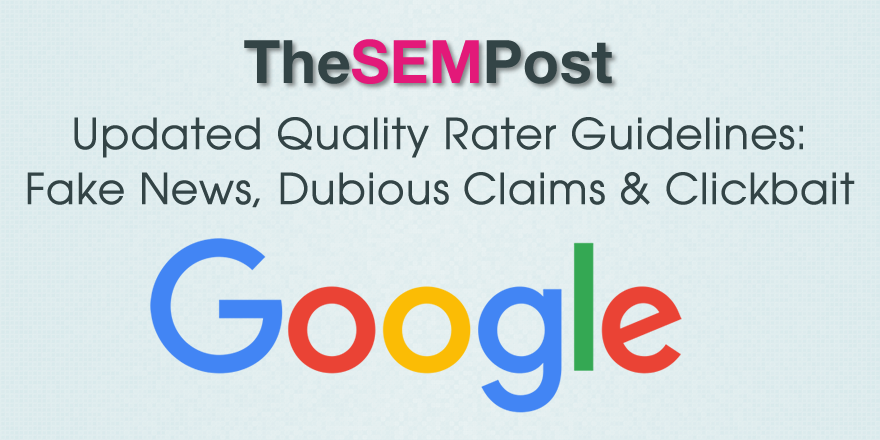 A year after the last Quality Rater’s Guidelines were released by Google, we have a brand new version. And it has some pretty interesting changes – Google is explicitly declaring fake news sites as low quality. And among the other sites being targeted? Those that use clickbait and those with dubious science claims. Hate sites are now specifically included as well.
A year after the last Quality Rater’s Guidelines were released by Google, we have a brand new version. And it has some pretty interesting changes – Google is explicitly declaring fake news sites as low quality. And among the other sites being targeted? Those that use clickbait and those with dubious science claims. Hate sites are now specifically included as well.
One of the reasons for the changes is so that Google has training data for these specific types of sites to be flagged as low quality. This means that Google is continuing to work on algos that will push these types of sites further down in the search results.
Clickbait is also targeted in these changes, as is a look at reputation, especially for information and news sites.
Let’s deep dive into the changes.
Contents [hide]
- 1 Table of contents
- 2 Your Money or Your Life
- 3 Website Reputation
- 4 Expertise, Authoritativeness and Trustworthiness
- 5 Highest Quality Pages
- 6 Low Quality Pages
- 7 Lowest Quality Pages
- 8 Deceptive Pages
- 9 Page Quality Criteria for Specific Types of Pages
- 10 Page Quality Rating FAQ
- 11 Understanding Mobile User Needs
- 12 Needs Met Rating Guidelines
- 13 Rating Porn, Foreign Language, Didn’t Load and Upsetting-Offensive Results
- 14 Relationship Between EAT and Needs Met
- 15 Non-Fully Meets Results for URL Queries
- 16 Final Thoughts
Table of contents
A quick note about the table of contents – it looks like many new sections were added, but looks can be deceiving. Many of these sections existed in the last version but Google is simply showing these sub-sub sections in the table of contents now.
There are a few new ones added, though, and they are detailed below.
Your Money or Your Life
The biggest change here is that news articles are now considered to be Your Money or Your Life pages. Google now wants to hold news sites to the highest standard possible, in order to make it harder for fake news sites to achieve higher quality ratings.
Added to the YMYL examples:
News articles or public/official information pages: webpages which are important for maintaining an informed citizenry, including information about local/state/national government processes, people, and laws; disaster response services; government programs and social services; news about important topics such as international events, business, politics, science, and technology. Please use your judgment and knowledge of your locale.
This addition isn’t surprising with the emphasis on legitimate news sources.
Google also added clarification under “news article page” throughout website examples to add that news article’s purpose is to “communicate information about an event or news topic.”
Website Reputation
Google has made some additions to website reputation needs.
Website Reputation
Google has added an additional section referring to news sites specifically.
A website’s reputation can also help you understand what a website is best known for, and as a result how well it accomplishes its purpose. For example, newspapers may be known for high quality, independent investigative reporting while satire websites may be known for their humor.
Again, this is a sign that Google wants to hold news sites to higher standards.
How to Search for Reputation Information
Google is now explicitly asking their raters to look for independent sources for rep analysis. Specifically, it also mentions a Facebook and Twitter brand page as not being suitable for independent reputation checks since the company itself is still involved in them.
Note: When searching for reputation information, try to find sources that were not written or created by the website or company itself. For example, IBM might have official Facebook or Twitter pages that it closely maintains, which would not be considered independent sources of reputation information about the company. See here for a Wikipedia article on identifying and using independent sources.
For local businesses looking at improving reputation, don’t assume now that Facebook and Twitter are good enough. While this only affects ratings, it is clearly evidence that Google wants to look outside those specific third parties for local rep checks.
Expertise, Authoritativeness and Trustworthiness
More about E-A-T
Google has added two more examples to their list of the type of E-A-T expected for specific types of sites, and both news and science sites have been added.
- High quality news articles should contain factually accurate content presented in a way that helps users achieve a better understanding of events. Established editorial policies and review processes are typically held by high quality news sources
- High quality information pages on scientific topics should represent wellestablished scientific consensus on issues where such consensus exists.
Characteristics of High Quality Pages
Google has made an addition to their first point on what makes a high quality page. The part bolded below was added.
High level of Expertise, Authoritativeness, and Trustworthiness (EAT), including the EAT of the publisher or individual author for news articles and information pages on YMYL topics.
Google is reiterating the fact that EAT on news sites and information pages is important for YMYL topics.
Satisfying Amount of High Quality Main Content
Again, news sites and factual content is highlighted here. Google made the following addition in the first paragraph about quality of main content:
For news articles and information pages, high quality MC must be factually accurate for the topic and must be supported by expert consensus where such consensus exists.
Google also specifically mentions satire, which is noteworthy since satire has become more intertwined with reality in many cases. Changes bolded:
High quality humor or satire should be entertaining, while factual accuracy is not a requirement as long as the page would be understood as satire by users.
A High Level of Expertise/Authoratativeness/Trustworthiness (E-A-T)
Not surprisingly, news was added to this section too. In the second paragraph, Google added:
For example, high quality news articles and information pages on scientific topics should represent established scientific consensus where such consensus exists.
Examples of High Quality Pages
Just a single example was added here, and you guessed it, it is a news example.

Highest Quality Pages
What makes a page Highest Quality?
Google made an addition to this, specifically mentioning publishers and authors of news articles, the addition is in bold.
Very high level of Expertise, highly Authoritative, and highly Trustworthy for the purpose of the page (EAT), including the EAT of the publisher or individual author for news articles and information pages on YMYL topics.
Examples of Highest Quality Pages
Google has added two news related sites as examples, including a site that is a factchecker.
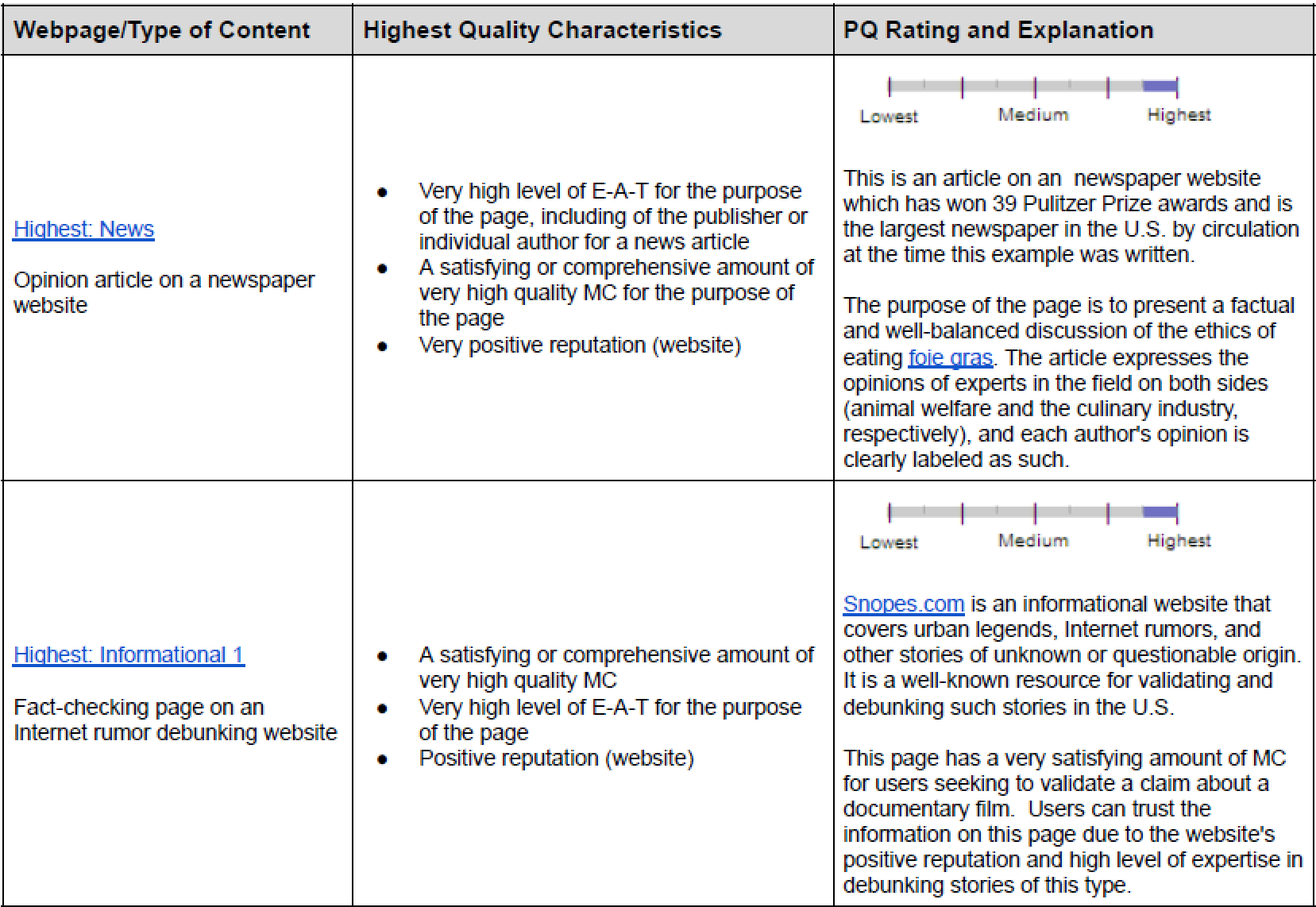
Low Quality Pages
Here is where the additions and changes get very interesting for all types of site owners, not just news publishers.
Low Quality Characteristics
Google has made a change specific types of ads in a page that can make a page low quality. Additions in bold:
MC is present, but difficult to use due to distracting/disruptive/misleading Ads, other content/features, etc.
So Google is making the clarification that ads don’t make a site low quality, but the type of ads or implementation of them can make it low quality.
Low Quality Main Content
Google has made multiple changes here, specifically targeting fake news, conspiracy theories and fake medical information.
The following points have been added to their list:
- Including inaccurate information, such as making things up, stretching the truth, or creating a false sense of doubt
about well established facts. - Failing to cite sources, or making up sources where none exist.
The failing to cite sources is an interesting one. Sometimes people just know certain things to be facts, whether common knowledge or just common within the niche so they don’t necessarily cite sources.
They also removed this from the list:
- Making things up
And fake news is also targeted specifically with this addition:
Inaccurate or misleading information presented as fact is also a reason for Low or even Lowest quality ratings.
And their keyword stuffing example just got a little less keyword heavy.
Previously: Argentina is a country. People live in Argentina. Argentina has borders.
Now: Argentina is a country. People live there. Argentina has borders
Should SEOs read anything into this change? Probably, since it was a definite decision to change this specific example.
Distracting/Distruptive/Misleading Titles, Ads, and Supplementary Content
Did you catch that now includes titles? Yes, Google is targeting clickbait titles as low quality now, when the content isn’t delivering what the title promised. Yes, your clickbait titles could result in your page being called low quality.
Added:
Misleading titles can result in a very poor user experience when users click a link only to find that the page does not match their expectations.
This has been something users have been complaining about for years, also impacts search quality when someone lands on one of these pages where the expectations were not met. So if you are using clickbait heavily, consider the fact that Google is very likely working on an algo that will prevent these types of pages from ranking well in the future.
Misleading Titles, Ads or SC
Google is also stressing the issue of misleading titles here too.
They added/changed the following, changes in bold:
Ads or SC which entice users to click with shocking or exaggerated titles, images, and/or text. These can leave users feeling disappointed or annoyed when they click and see the actual and far less interesting content. Here is an example of a page with shocking/exaggerated titles, images, and text in the Ads and SC.
They also added:
Titles of pages or links/text in the SC that are misleading or exaggerated compared to the actual content of the page. This can result in a very poor user experience when users read the title or click a link only to find that the page does not match their expectations. Here is an example of a page with a misleading/exaggerated title.
Again, if you are utilizing clickbait, you will want to begin thinking alternative strategies.
Negative Reputation
Google is also targeting news sites for reputation research, likely to ensure the raters research to ensure the site they are rating is a legitimate news site – or if it is not, rate accordingly.
Added:
Reputation research is also critical for information pages and news websites, particularly those on YMYL topics. The lack of any reputation information at all for a YMYL website may be a reason for a Low rating.
If you are a news site, you should consider what your online reputation is for the site, and if necessary, improve it.
Lacking Expertise, Authoritativeness or Trustworthiness (EAT)
Medical science is added here, with Google wanting to target sites that are spreading inaccurate – and downright dangerous – medical advice that has been debunked or without any data to back up the claims.
Additions / changes are in bold:
Some topics demand expertise for the content to be considered trustworthy. YMYL topics such as medical advice, legal advice, financial advice, etc. should come from authoritative sources in those fields, must be factually accurate, and must represent scientific/medical consensus within those fields where such consensus exists. Even everyday topics, such as recipes and house cleaning, should come from those with experience and everyday expertise in order for the page to be trustworthy.
Examples of Low Quality Pages:
Google has added two new examples here:
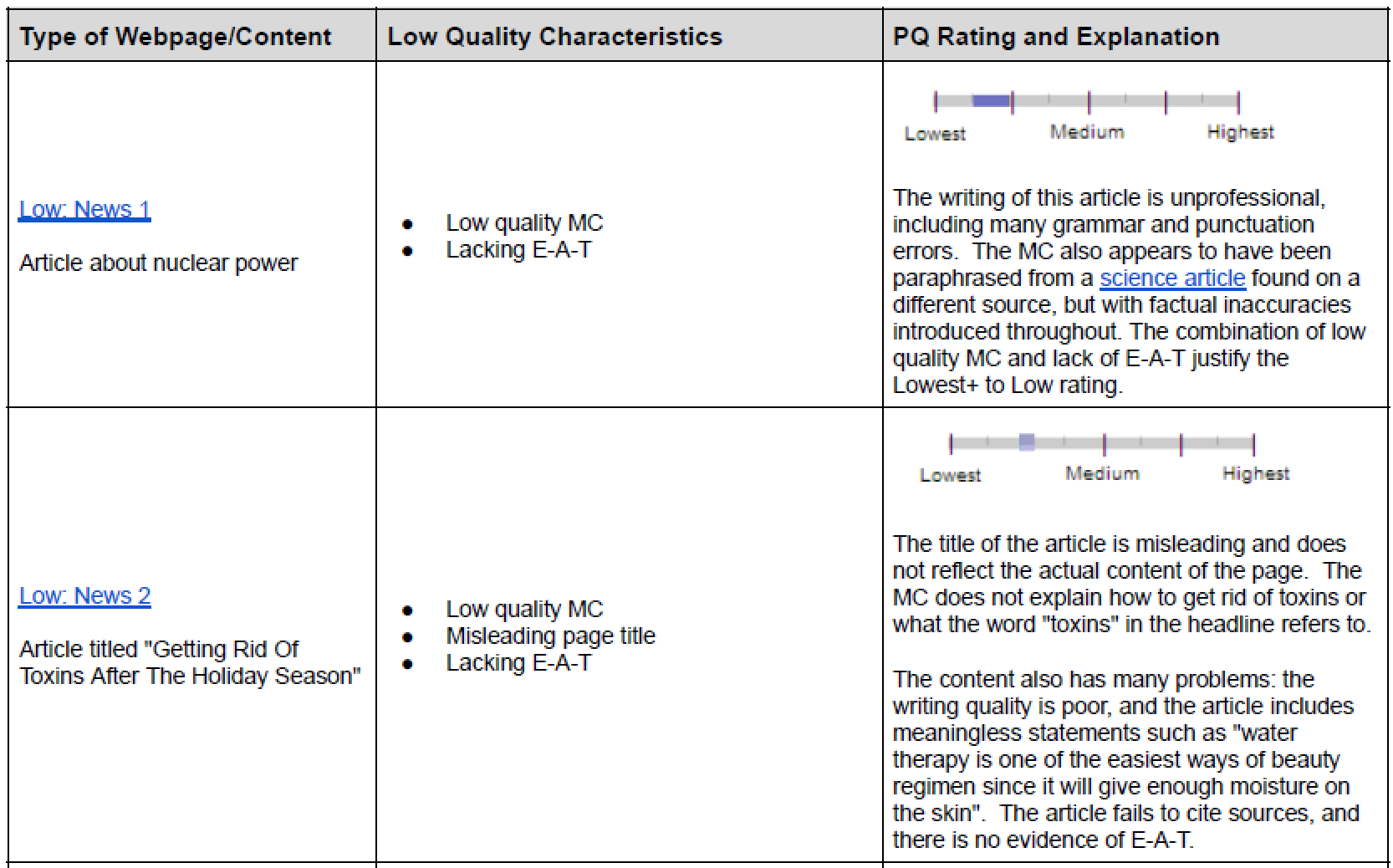
Lowest Quality Pages
Here lies the lowest of the low quality, and Google has made major changes to this section.
First, is Google’s target of hate sites. Changes to this section in bold:
Important: Websites and pages that are created to harm users, mislead or misinform users, or only make money with no attempt to help users should be rated Lowest . Webpages created with the sole purpose of promoting hate or violence against a group of people based on criteria including (but not limited to) race or ethnicity, religion, gender, nationality or citizenship, disability, age, sexual orientation, or veteran status should also be rated Lowest .
They have also made some major changes to the list of “pages or websites that are highly untrustworthy, unreliable, unauthoritative, inaccurate or misleading.”
Under “Deceptive pages or websites” they have added the following examples:
- Pages or websites which misrepresent the website’s owner or purpose, such as by impersonating a different site (e.g., copied logo or branding of an unaffiliated site, URL that mimics another site’s name).
- Pages or websites which appear to be deliberate attempts to misinform or deceive users by presenting factually inaccurate content (e.g., fake product reviews, demonstrably inaccurate news, etc.).
These additions are very clearly targeting fake news sites as well as sites that are impersonating legitimate news sources. It also impacts those sites that are posting their own fake product reviews.
Google has also added the following:
- Pages or websites created with no expertise or pages which are highly untrustworthy, unreliable, unauthoritative, inaccurate, or misleading.
- Pages or websites with factually inaccurate content which can cause harm to users regardless of their purpose or intent (e.g., inaccurate medical information; inaccurate information about how to vote, obtain a visa or green card, pay government taxes, etc.).
- [Violations of the Google Webmaster Quality Guidelines], such as pages on websites with little or no original content on the website as a whole.
- Pages or websites created with the sole purpose of promoting hate or violence against a group of people based on criteria including (but not limited to) race or ethnicity, religion, gender, nationality or citizenship, disability, age, sexual orientation, or veteran status.
Noteworthy are the sites/pages that promote hate to a wide variety of groups, and also those not listed.
Sites with little to no original content has also been added, which should be noted by those publishing a lot of syndicated content.
Deceptive Pages
Also with some major changes are deceptive pages.
Deceptive Page Purpose
Here we have the interesting addition of if a page is created to “manipulate users in order to benefit a person, business, government, or other organization politically, monetarily, or otherwise.” While not mentioned specifically, it isn’t heard to think of the fact this targets sites that were used to publish fake news and influence the US elections last year.
All these examples were added as examples of pages or sites with deceptive page purpose:
- A webpage or website that impersonates a different site (e.g., copied logo or branding of an unaffiliated site, URL that mimics another site’s name, etc.).
- A webpage or website looks like a news source or information page, but in fact has articles with factually inaccurate information to manipulate users in order to benefit a person, business, government, or other organization politically, monetarily, or otherwise.
- A nonsatirical webpage or website presents unsubstantiated conspiracy theories or hoaxes as if the information were factual.
Clearly this targets fake news, including those that are impersonating legitimate news sites as well as conspiracy theory sites.
Misleading or Inaccurate YMYL Informational Main Content
This is a brand new section. This addition backs up the addition of news sites as YMYL standards. It also covers information type sites where the content is wholly inaccurate, often with deliberate intentions to mislead.
Misleading or inaccurate MC on an informational page should cause the overall PQ rating to be Low or Lowest . If the inaccurate information could potentially harm users in any way (e.g., inaccurate medical information; inaccurate information about how to vote, obtain a visa or green card, pay government taxes, etc.), use the Lowest rating. If the inaccuracy appears to be deliberate and intended to mislead (e.g., fake product reviews, demonstrably inaccurate news, etc.), use Lowest . Please use your judgment.
Promotion of Hate or Violence
This is another new addition to reflect the change where hate sites are now considered lowest quality.
Use the Lowest rating for pages created with the sole purpose of promoting hate or violence against a group of people based on criteria including (but not limited to) race or ethnicity, religion, gender, nationality or citizenship, disability, age sexual orientation, or veteran status. Websites advocating hate or violence can cause real world harm.
Reputation research is important for identifying websites which promote hate and violence. The Pew Research Center , the Anti Defamation League, and the Southern Poverty Law Center are some reputable sources that can be used for reputation research.
Some websites may not have reputation information available. In this case, please use your judgment based on the MC of the page and knowledge of your locale.
Not surprising that this is added, as Google has received some negative press
Examples of Lowest Quality Sites
There are three new examples added here, dealing with both fake news and news sites that are deceptively mimicking legitimate new sites to make people think they are on the true legitimate news site.
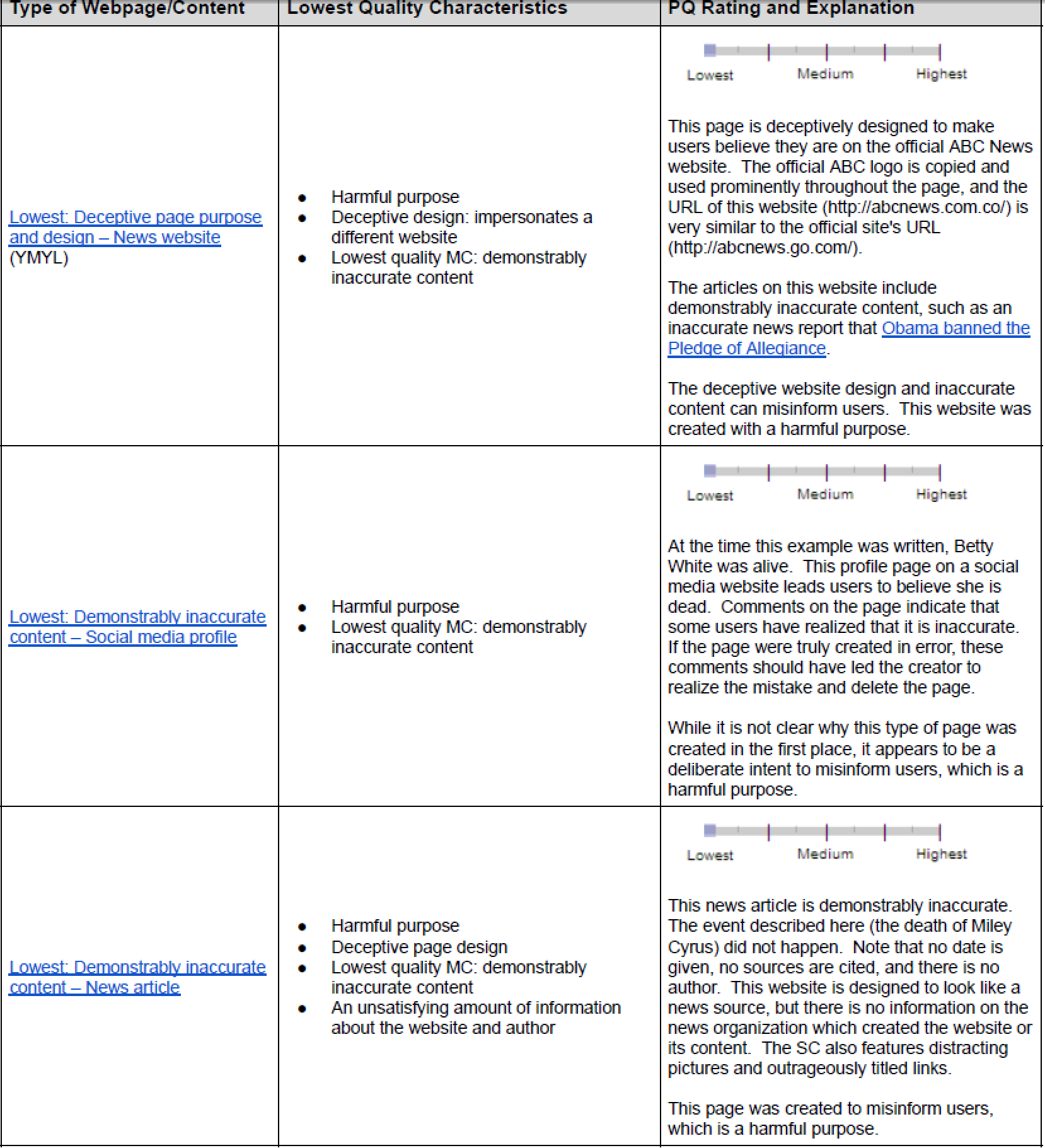
Page Quality Criteria for Specific Types of Pages
Ratings for Encyclopedia Pages
This section got some updates as well, specifically around the issue of expertise. Additions are in bold:
A Wikipedia article on a non YMYL topic ( example ) with a satisfying amount of accurate information and trustworthy external references can usually be rated in the High range. Some Wikipedia articles may even be rated higher, although remember that a high level of expertise is required for YMYL topics. A PQ rating in the Medium range is often appropriate for pages with less extensive MC and external references. Naturally, Wikipedia articles with very little MC should get lower PQ ratings. Factual inaccuracy is a sufficient reason for a Low or Lowest rating.
Page Quality Rating FAQ
One change made in this section was surrounding celebrity gossip sites, and the perception that they are always low quality. Changes are in bold:
Aren’t there some types of pages or topics, such as celebrity gossip, that always have Low quality content?
For almost any type of page or informational topic, there is a range of content quality. Remember that high quality content is defined as content that takes time, effort, expertise, and talent/skill. Pages which have a harmful purpose should be rated Lowest quality, regardless of their topic.
For example, there are both High and Low quality celebrity gossip pages. Often, the purpose of these pages is to share scandalous, but potentially true personal information about celebrities. We can consider the MC of a gossip page to be high quality if it is interesting
Notable is that they specifically mention information sites, which cover a huge swath of sites.
Understanding Mobile User Needs
Understanding the Query
A small change mentions that “Some tasks include a query research link, which you should use.” So Google is giving some background to their raters for some topics or queries, so they can understand the results better.
Rating on Your Phone Issues
They have clarified one of the points that discuss the use of an Android device. It now reads:
You should assume queries were issued on a smartphone. For some queries, there are results that are helpful for specific types of phones — for example, some apps will only work on an Android or iPhone. Please assume that queries with device specific results were issued on an Android device, unless explicitly stated otherwise in the instructions.
Needs Met Rating Guidelines
Needs Met section has also received some changes and updates to reflect the overall theme of changes.
Fully Meets (FullyM)
Google now wants raters to verify the accuracy of facts or pieces of information before giving a Fully Meets rating, reflecting the changes that Google wants to ensure it is the highest rated sites that are rated highest.
Google added:
Before using the Fully Meets rating for queries seeking a very specific fact or piece of information, you must check for accuracy and confirm that the information is supported by expert consensus where such consensus exists.
Examples of Fully Meets (FullyM) Result Blocks
One new example was added here:
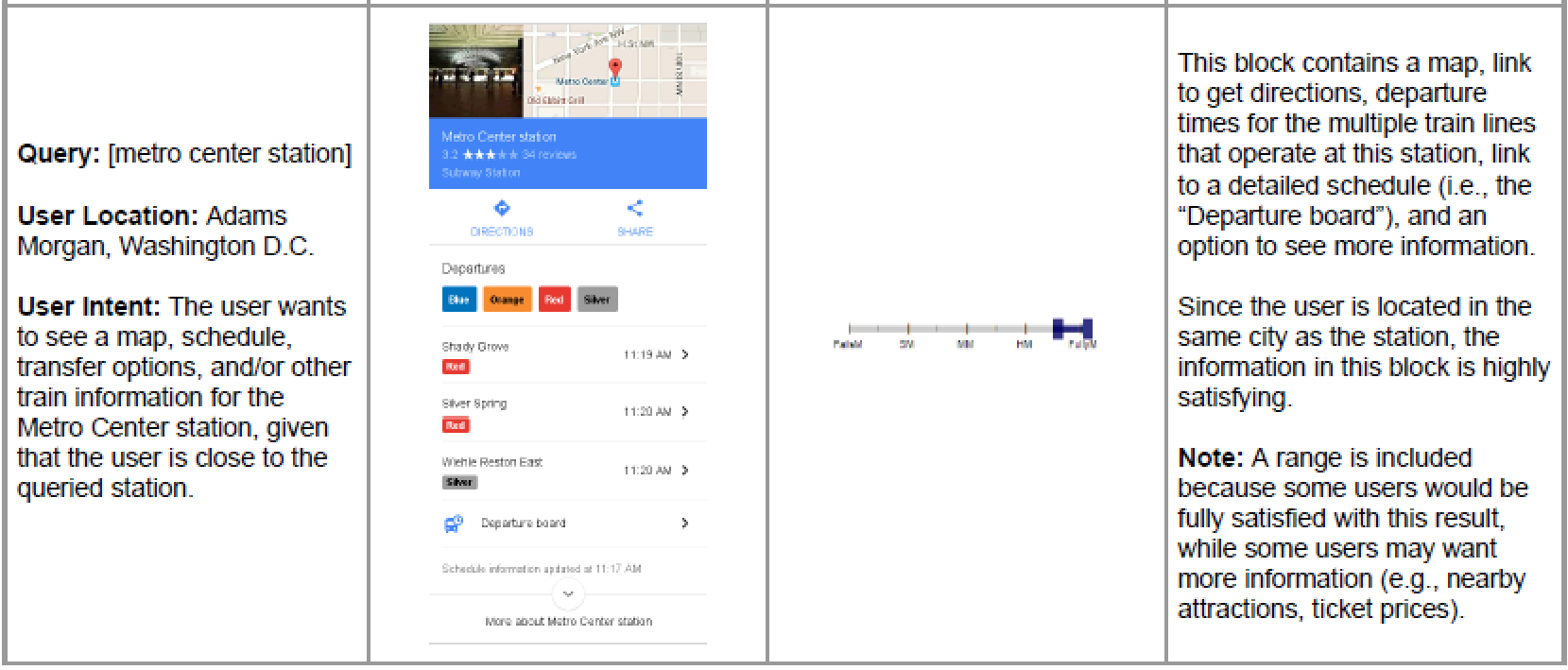
Highly Meets (HM)
New additions reflect fake nes, info pages and science based articles.
Added:
In order to receive a Highly Meets rating, information pages such as encyclopedia articles and news articles must be accurate and highly credible. Highly Meets medical and scientific information pages must represent wellestablished scientific/medical consensus unless the user is clearly seeking an alternative viewpoint. For all information pages, you must check for accuracy and confirm that the information is supported by expert consensus where such consensus exists.
Examples of Highly Meets (HM) Results Block
One amusing change is the example that used to be for Shaun the Sheep movie has been replaced by a Fear the Walking Dead example.
A new typo example has been added for a maps related search feature, but also bring up the fact that voice can result in mistranscribed results.
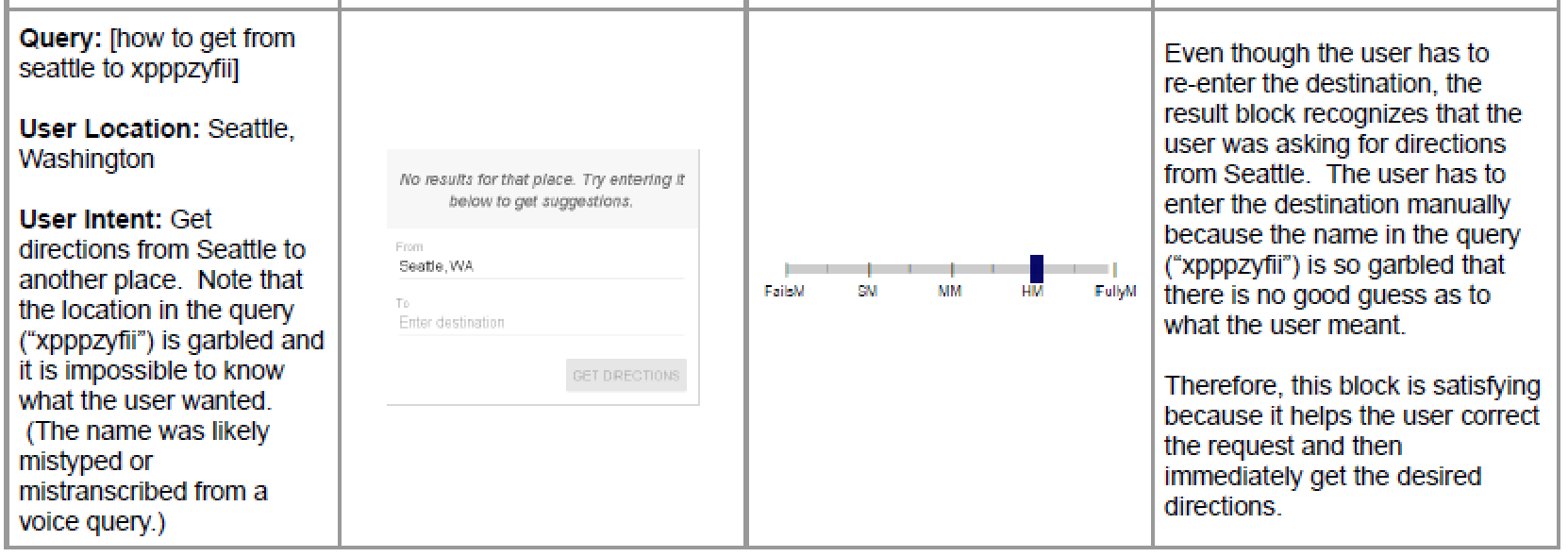
And a large number of more examples were added for a variety of searches and search types, including hoaxes.
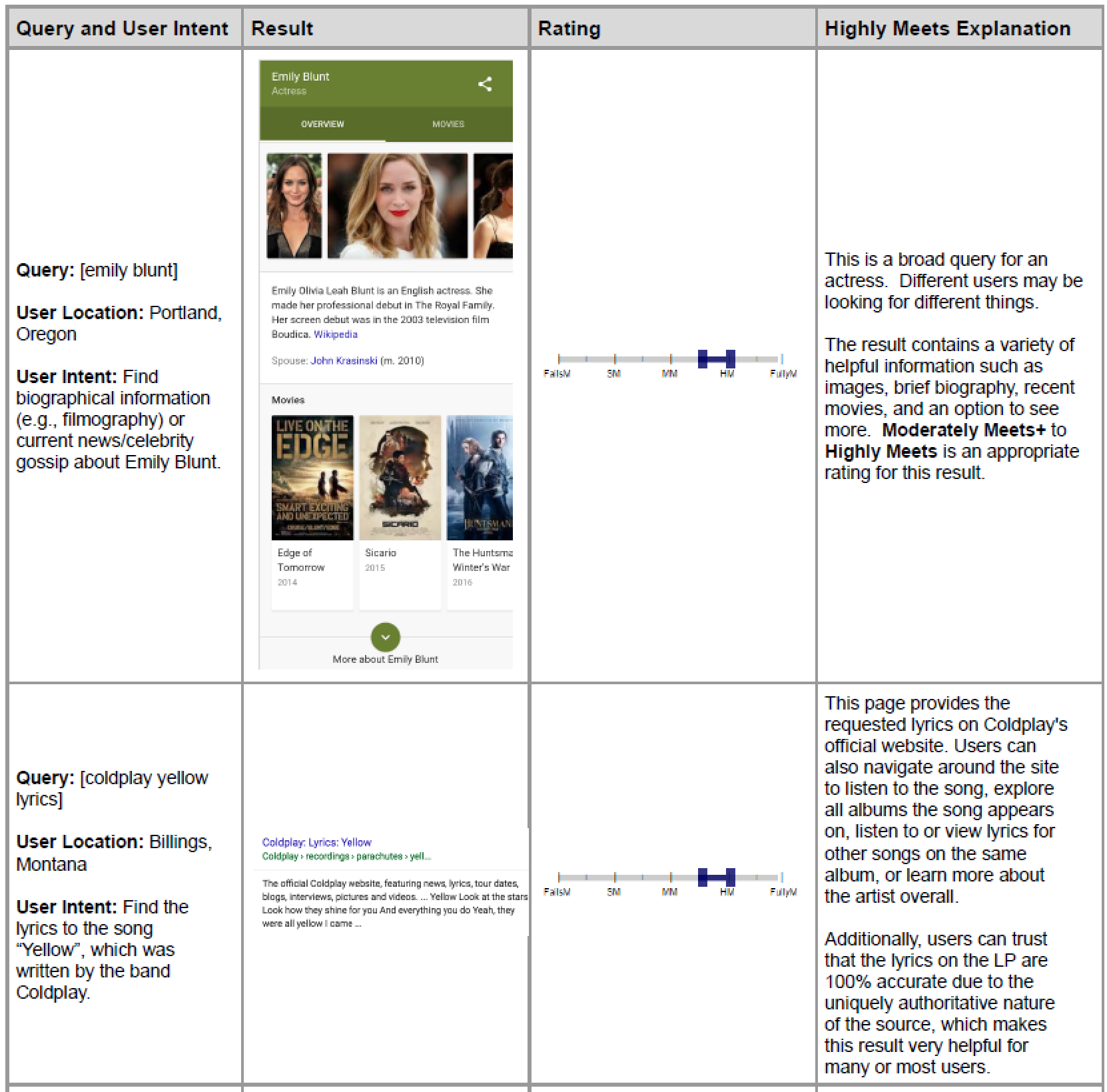

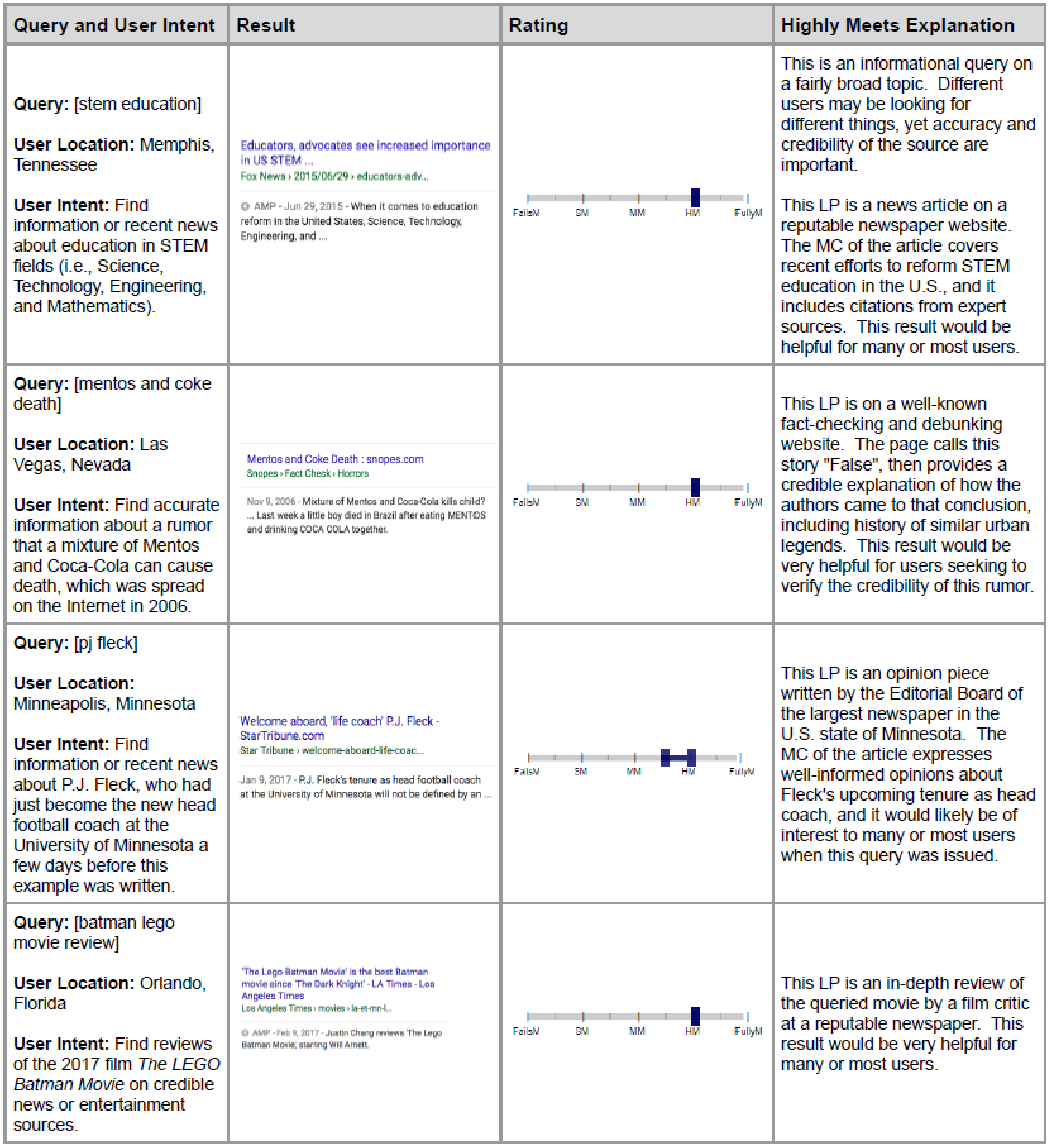
Slighly Meets (SM)
Interestingly, this one mentions content that is too niche for the search. So it sounds as though if you have content for a more advanced audience of your niche, but it targets a less technical type search, it could be rated as Slightly Meets.
Changes are bolded:
A rating of Slightly Meets is assigned to results that are helpful and satisfying for some or few users. Slightly Meets results may serve a minor interpretation, be low quality, have stale or outdated information, have some minor inaccuracies, be too specific, too broad, too niche for the general user population considering the query, etc. to receive a higher rating.
So it seems that it might be a bit more forgiving for small inaccuracies, so long as they aren’t wildly inaccurate.
Fails to Meet (FailsM)
Not surprisingly, this section received a massive update.
Under a new section “Fails to Meet should be used for the following types of Lowest Page Quality results:”
- Results which harm users (e.g., malicious download pages, “phishing” pages or websites, etc.).
- Pages or websites which misrepresent the website’s owner or purpose, such as by impersonating a different site (e.g., copied logo or branding of an unaffiliated site, URL that mimics another site’s name).
- Pages or websites which appear to be deliberate attempts to misinform or deceive users by presenting factually inaccurate content (e.g., fake product reviews, demonstrably inaccurate news, etc.).
- Pages or websites with factually inaccurate content which can cause harm to users regardless of their purpose or
intent (e.g., inaccurate medical information; inaccurate information about how to vote, obtain a visa or green card,
pay government taxes, etc.).
Again, targeting fake news, deceptive and inaccurate science and impersonation.
Also added as a new section “The following should also be rated Fails to Meet because they lead to very poor and upsetting user experiences:”
- Porn results for non-pornseeking queries.
- Upsetting or offensive results for queries which are not obviously seeking upsetting or offensive content.
- Pages which directly contradict wellestablished scientific or medical consensus for queries seeking scientific or medical information, unless the query indicates the user is seeking an alternative viewpoint.
- Pages which directly contradict well established historical facts (e.g., unsubstantiated conspiracy theories), unless the query clearly indicates the user is seeking an alternative viewpoint .
The point about “unless the query clearly indicates the user is seeking an alternative viewpoint” is an important distinction. In many (but not all) of the recent Google examples that have been publicized for either conspiracy theories or fake news, the intent of the query was actually searching for these “alternative viewpoints.”
Examples of Fails to Meet (FailsM) Result Blocks
To match the above changes, Google has also added specific examples, including the infamous Stormfront Holocaust example.
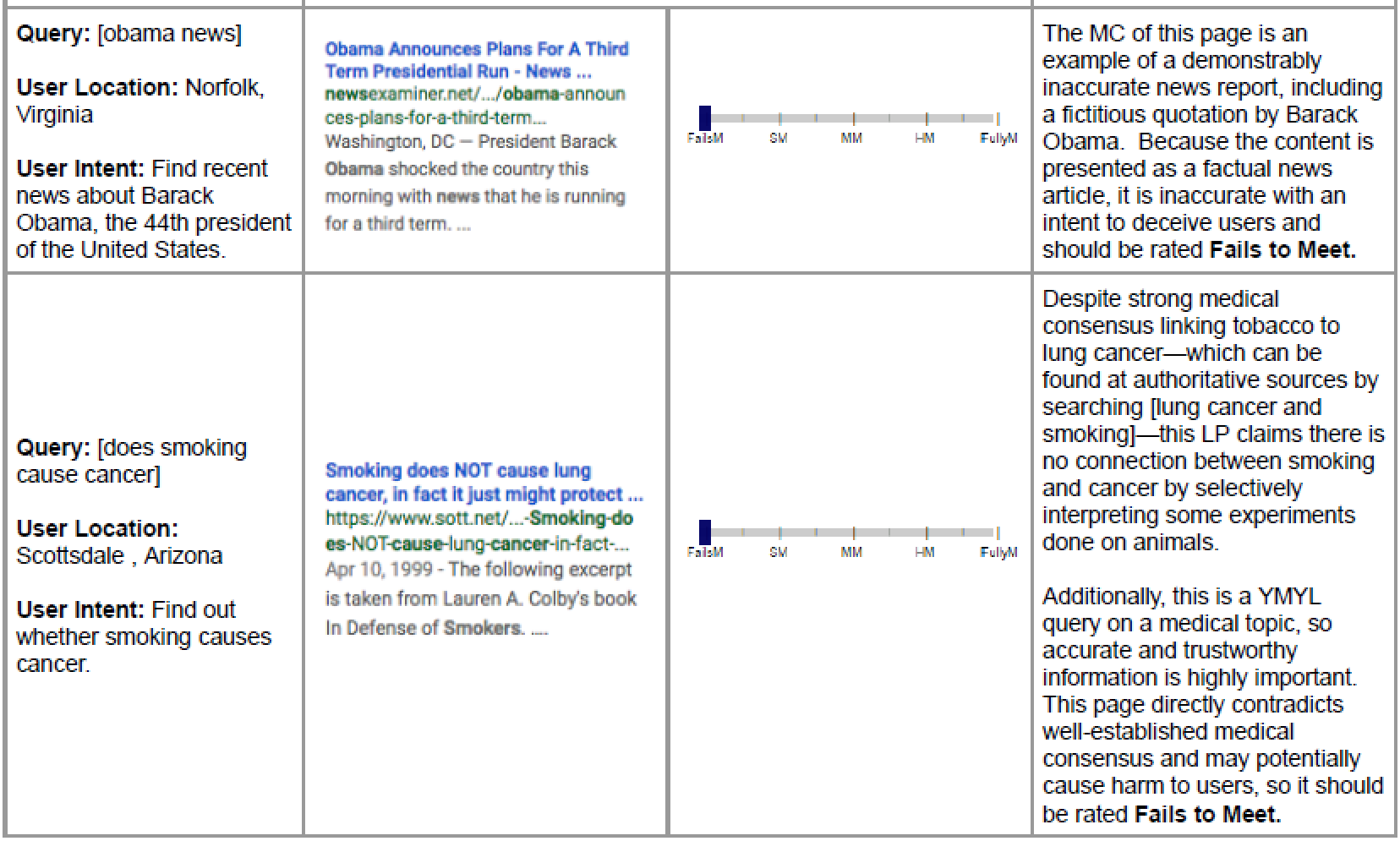
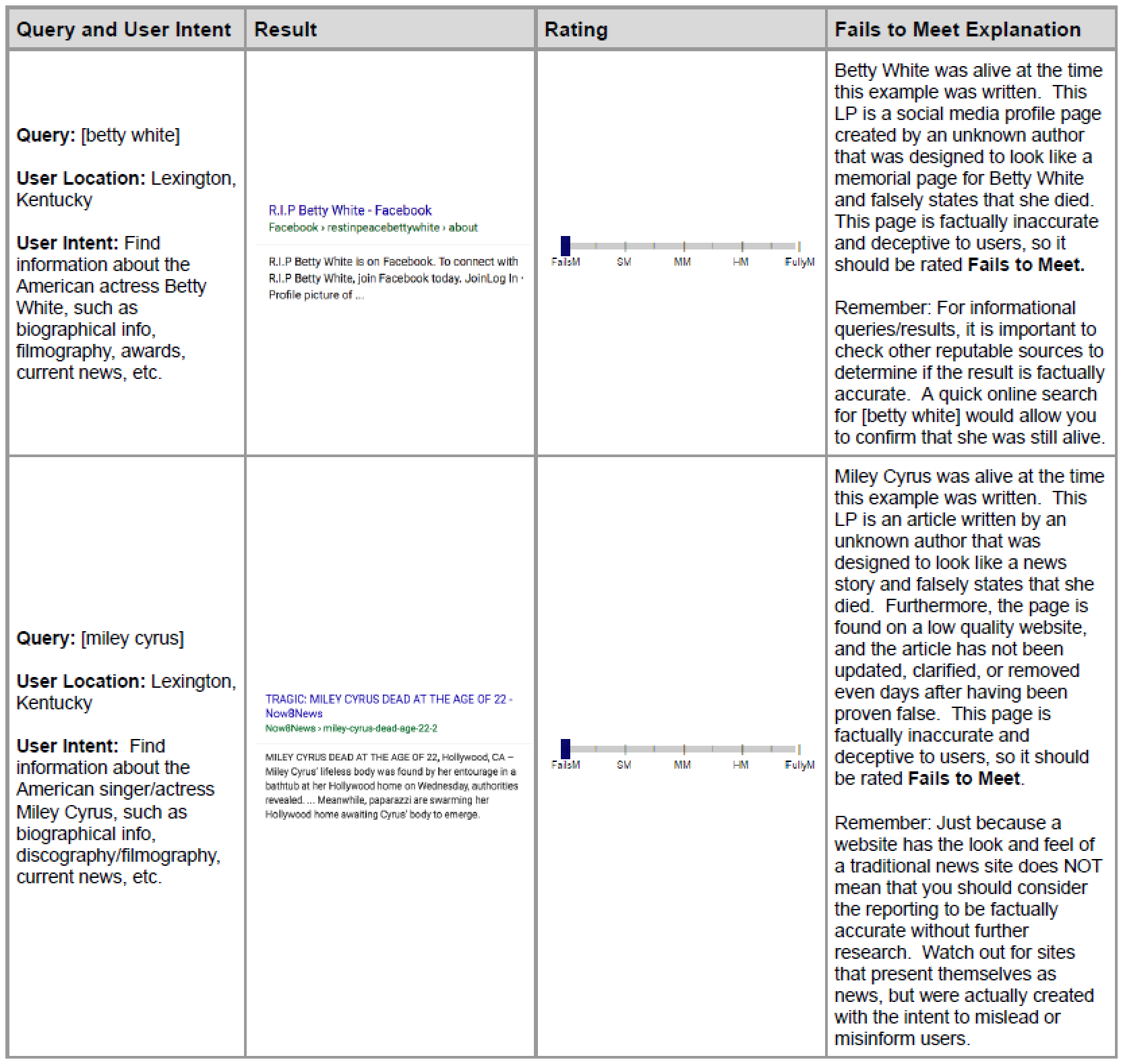
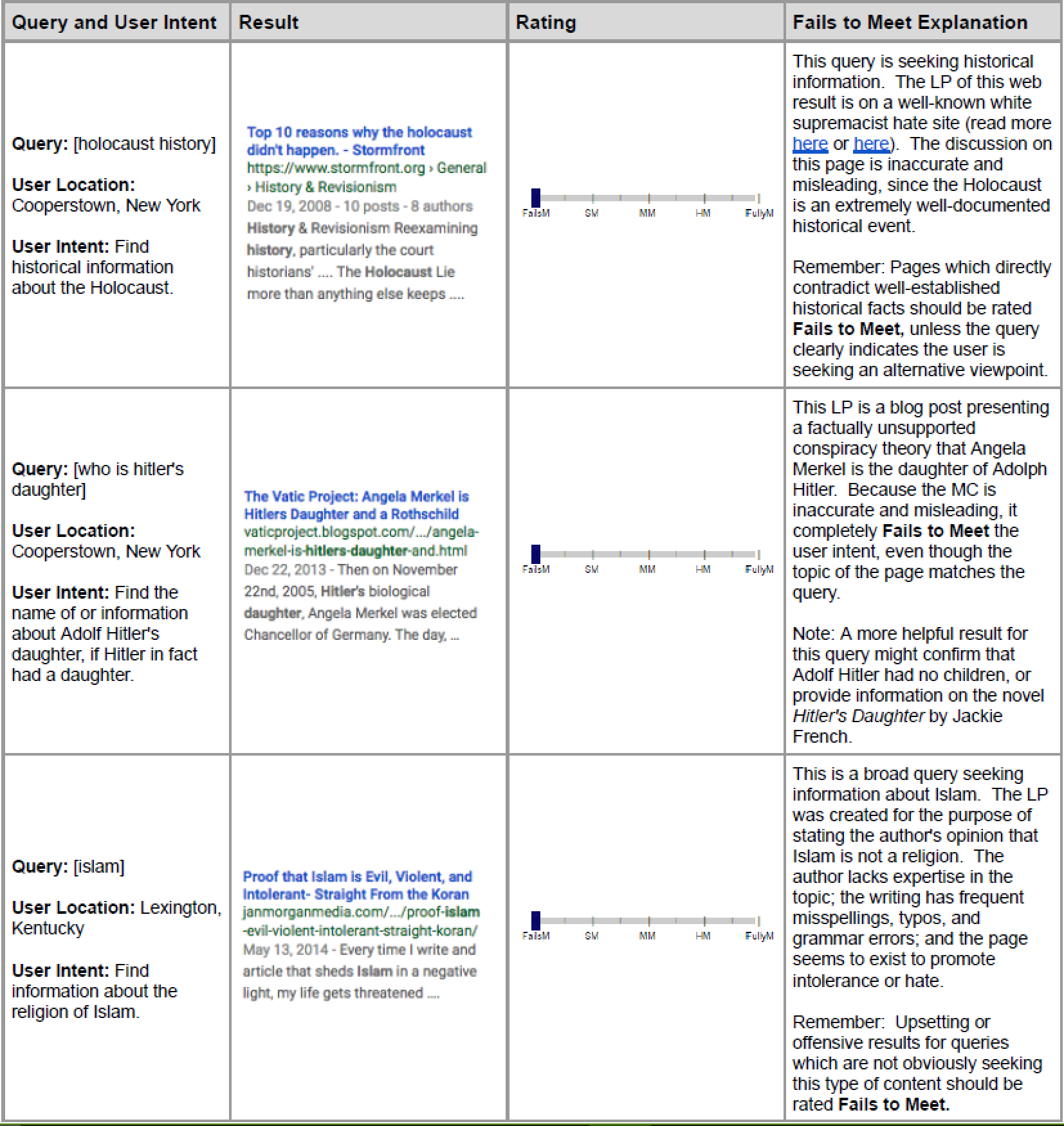
Rating Porn, Foreign Language, Didn’t Load and Upsetting-Offensive Results
New to this section is the “Upsetting-Offensive Results” and the associated flag in the rater’s view.
Reporting Illegal Images
There is higher visibility given to the reference that raters must follow US federal law on child pornography. However, Google has removed the definition to bestiality and reporting them.
Upsetting-Offensive Flag
This is a brand new section to the rater guidelines.
The Internet contains all sorts of content, including content which many users find offensive or upsetting. Additionally, users of all ages, genders, races, and religions use the Internet to understand the world and other people’s points of view. Users may issue queries on sensitive topics to understand why people believe, say, or do upsetting or offensive things. Search engines exist to allow users to find the information they are looking for.
Please assign the Upsetting-Offensive flag to all web results that contain upsetting or offensive content from the perspective of users in your locale, even if the result satisfies the user intent.
So any sites that would be considered upsetting, such as hate sites, will be flagged as such by the raters.
Using the Upsetting-Offensive Flag
Another new section, as this flag is brand new for raters. It is important to note that Google says even if these types of sites meet the query, they should still be flagged. They are also considering regionality, which is important to consider since raters are located all over the world.
Assign the Upsetting-Offensive flag to web results that contain upsetting or offensive content. Please represent users in your locale and use your judgment to determine what constitutes upsetting or offensive content. As a general rule of thumb, Upsetting-Offensive results contain content which is so upsetting or offensive that it should only be shown if the
query is explicitly seeking this type of content.Upsetting-Offensive content typically includes the following:
- Content that promotes hate or violence against a group of people based on criteria including (but not limited to) race or ethnicity, religion, gender, nationality or citizenship, disability, age, sexual orientation, or veteran status.
- Content with racial slurs or extremely offensive terminology.
- Graphic violence, including animal cruelty or child abuse.
- Explicit how to information about harmful activities (e.g., how tos on human trafficking or violent assault).
- Other types of content which users in your locale would find extremely upsetting or offensive.
Remember to assign the Upsetting-Offensive flag to all upsetting/offensive results, even if they satisfy the user intent.
Here are examples showing the flag, and whether the flag is appropriate in each example or not:
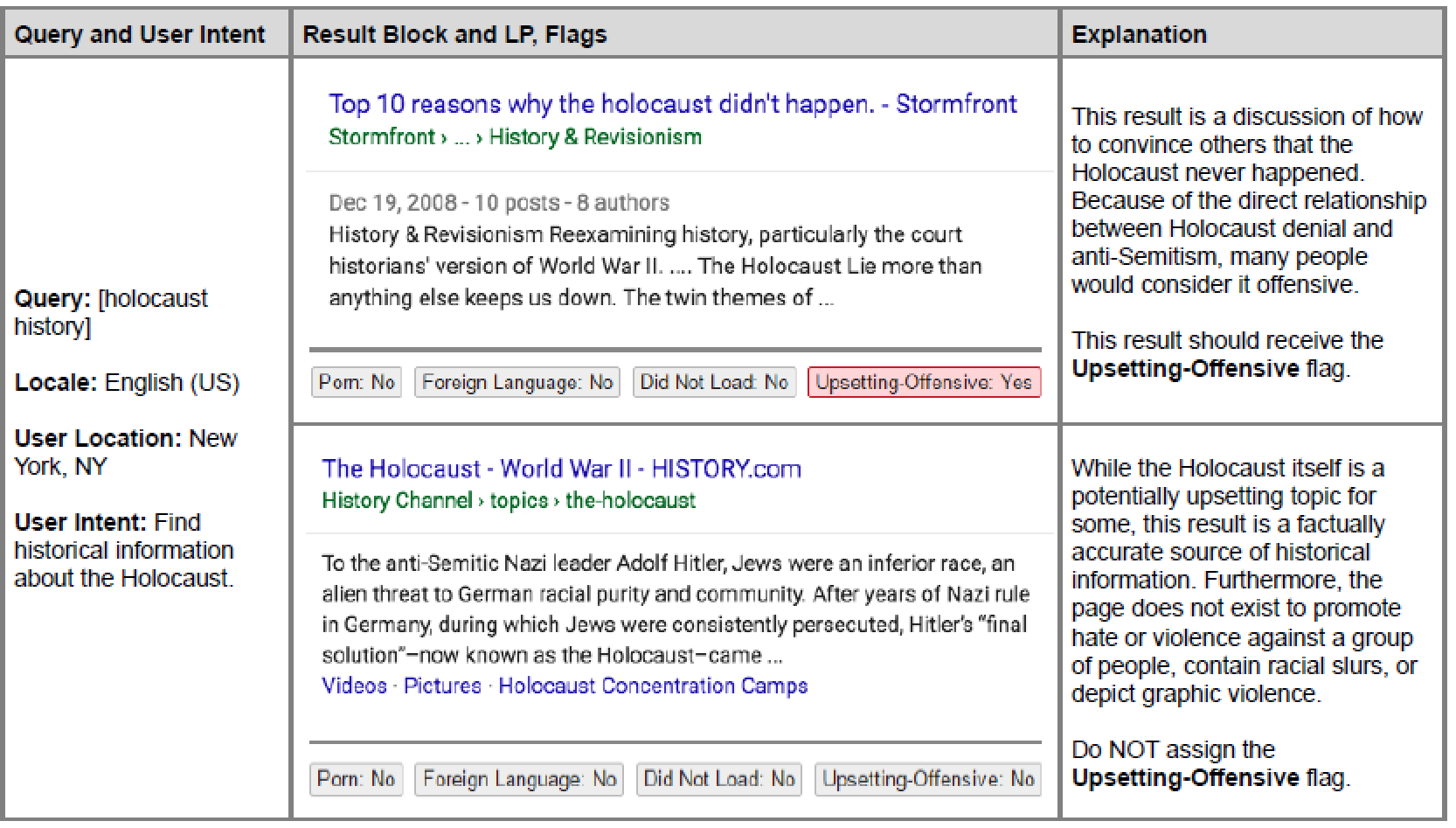
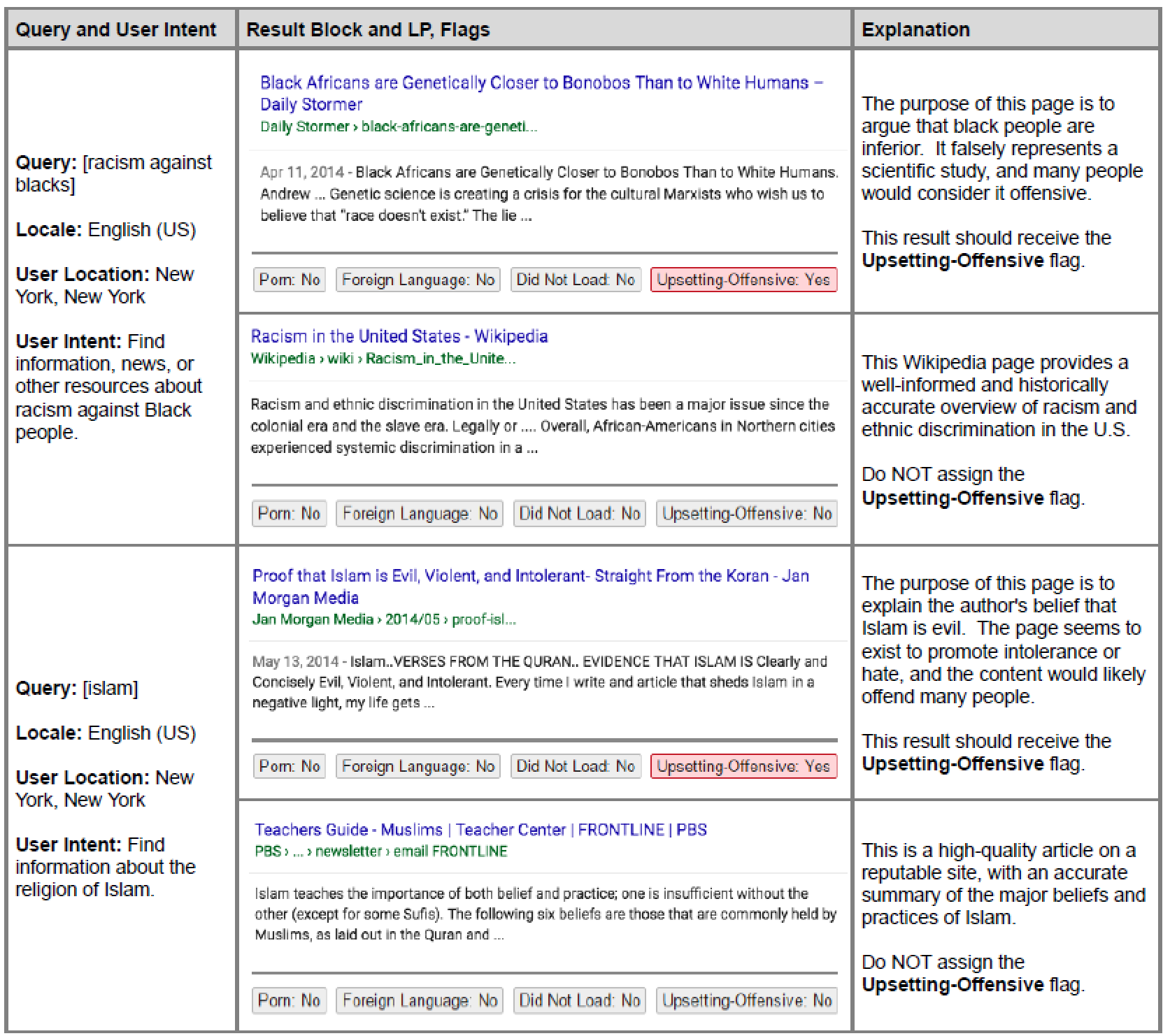
Needs Met for Upsetting-Offensive Tolerant Queries
Another new section to support the new flag.
Remember that users of all ages, genders, races, and religions use search engines for a variety of needs. One especially important user need is exploring subjects which may be difficult to discuss in person. For example, some people may hesitate to ask what racial slurs mean. People may also want to understand why certain racially offensive statements are made. Giving users access to resources that help them understand racism, hatred, and other sensitive topics is beneficial to society.When the user’s query seems to either ask for or tolerate potentially upsetting, offensive, or sensitive content, we will call
When the user’s query seems to either ask for or tolerate potentially upsetting, offensive, or sensitive content, we will call the query a “Upsetting-Offensive tolerant query”. For the purpose of Needs Met rating, please assume that users have a dominant educational/informational intent for Upsetting-Offensive tolerant queries. All results should be rated on the Needs Met rating scale assuming a genuine educational/informational intent.
In particular, to receive a Highly Meets rating, informational results about Upsetting-Offensive topics must:
- Be found on highly trustworthy, factually accurate, and credible sources, unless the query clearly indicates the user is seeking an alternative viewpoint.
- Address the specific topic of the query so that users can understand why it is upsetting or offensive and what the sensitivities involved are.
Important:
- Do not assume that Upsetting-Offensive tolerant queries “deserve” offensive results.
- Do not assume UpsettingOffensive tolerant queries are issued by racist or “bad” people.
- Do not assume users are merely seeking to validate an offensive or upsetting perspective.
Google also includes examples, including some that have been reported in the news recently.

And more examples showing the rater’s side of how to handle these types of queries.
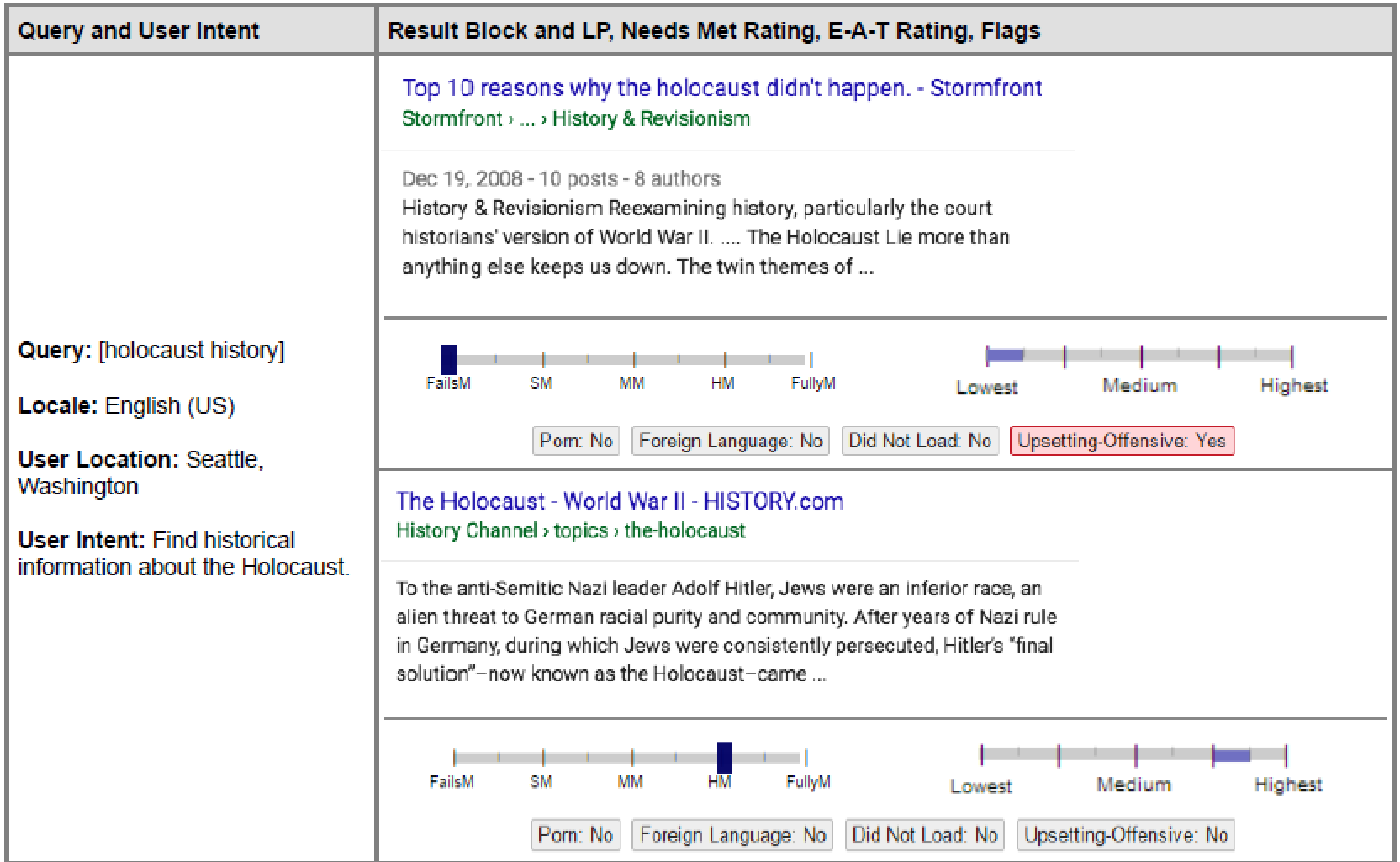
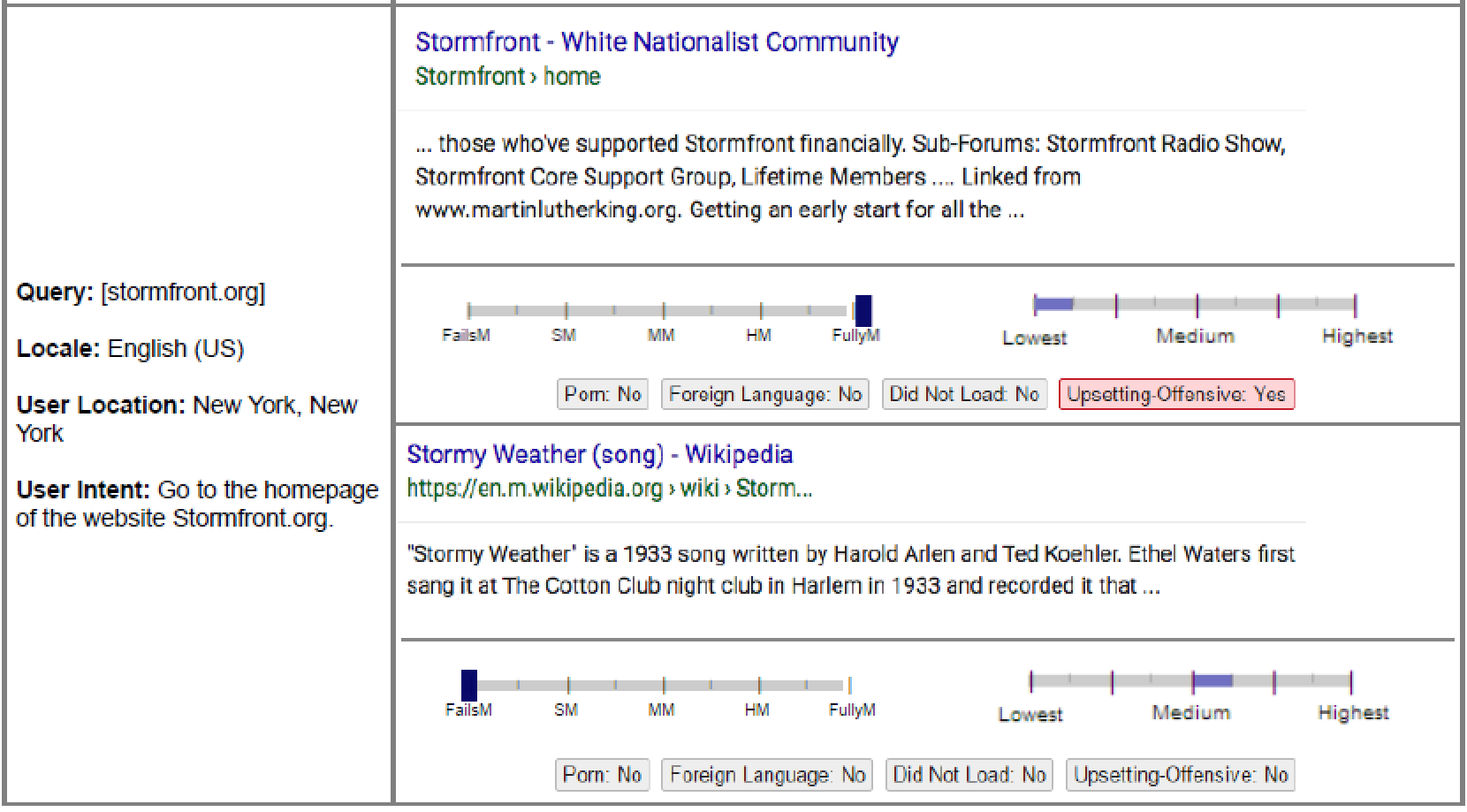
Relationship Between EAT and Needs Met
Google has made a change to the Slightly Meets section. Changes are bolded.
SM is often an appropriate rating for low quality but ontopic pages. However, a page can have such low EAT that it is useless for nearly all queries. Gibberish pages are a good example of pages with low EAT that should be rated FailsM . An exception to this is queries with clear website intent, where the target website should berated FullyM even if the page has low EAT.
Non-Fully Meets Results for URL Queries
For some reason, an example for coldwatercreek.com was replaced by one for potterybarn.com
Final Thoughts
It is not surprising that Google is targeting fake news, science denial and clickbait. We have seen them moving in that direction for a while by those who watch Google algo changes. And expect more of this as Google will be able to more effectively test algo changes with their raters to combat these types of low quality search results.
I also spoke with Google prior to these guidelines being released, and have included their comments here, including the fact we likely won’t see these changes incorporated into the regular webmaster guidelines.
The full guidelines have been published by Google here.